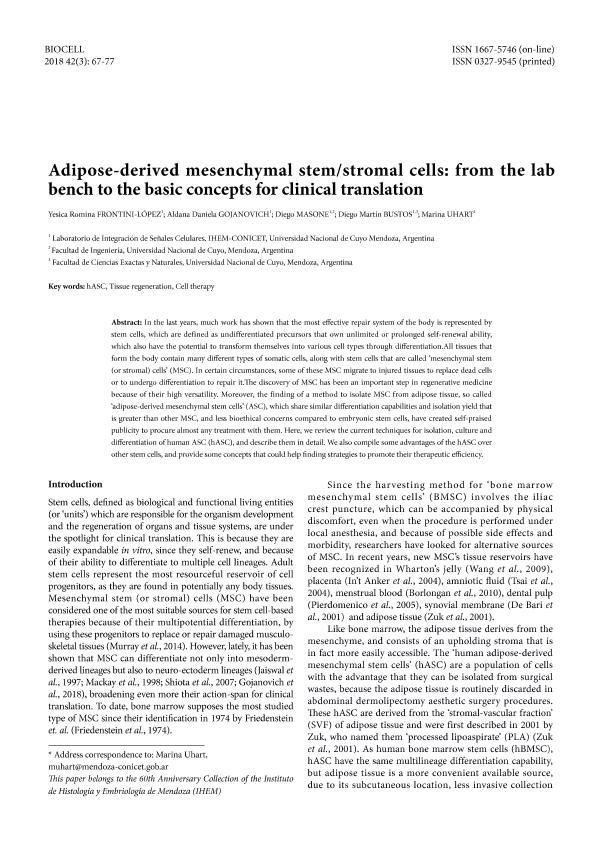Mostrar el registro sencillo del ítem
dc.contributor.author
Frontini López, Yesica Romina

dc.contributor.author
Gojanovich, Aldana Daniela

dc.contributor.author
Masone, Diego Fernando

dc.contributor.author
Bustos, Diego Martin

dc.contributor.author
Uhart, Marina

dc.date.available
2020-01-20T19:28:55Z
dc.date.issued
2018-12
dc.identifier.citation
Frontini López, Yesica Romina; Gojanovich, Aldana Daniela; Masone, Diego Fernando; Bustos, Diego Martin; Uhart, Marina; Adipose-derived mesenchymal stem/stromal cells: from the lab bench to the basic concepts for clinical translation; Instituto de Histología y Embriología "Dr. Mario Burgos"; Biocell; 42; 3; 12-2018; 67-77
dc.identifier.issn
0327-9545
dc.identifier.uri
http://hdl.handle.net/11336/95266
dc.description.abstract
In the last years, much work has shown that the most effective repair system of the body is represented by stem cells, which are defined as undifferentiated precursors that own unlimited or prolonged self-renewal ability, which also have the potential to transform themselves into various cell types through differentiation.All tissues that form the body contain many different types of somatic cells, along with stem cells that are called ‘mesenchymal stem (or stromal) cells’ (MSC). In certain circumstances, some of these MSC migrate to injured tissues to replace dead cells or to undergo differentiation to repair it.The discovery of MSC has been an important step in regenerative medicine because of their high versatility. Moreover, the finding of a method to isolate MSC from adipose tissue, so called ‘adipose-derived mesenchymal stem cells’ (ASC), which share similar differentiation capabilities and isolation yield that is greater than other MSC, and less bioethical concerns compared to embryonic stem cells, have created self-praised publicity to procure almost any treatment with them. Here, we review the current techniques for isolation, culture and differentiation of human ASC (hASC), and describe them in detail. We also compile some advantages of the hASC over other stem cells, and provide some concepts that could help finding strategies to promote their therapeutic efficiency.
dc.format
application/pdf
dc.language.iso
eng
dc.publisher
Instituto de Histología y Embriología "Dr. Mario Burgos"

dc.rights
info:eu-repo/semantics/openAccess
dc.rights.uri
https://creativecommons.org/licenses/by-nc-sa/2.5/ar/
dc.subject
HASC
dc.subject
TISSUE REGENERATION
dc.subject
CELL THERAPY
dc.subject.classification
Bioquímica y Biología Molecular

dc.subject.classification
Ciencias Biológicas

dc.subject.classification
CIENCIAS NATURALES Y EXACTAS

dc.title
Adipose-derived mesenchymal stem/stromal cells: from the lab bench to the basic concepts for clinical translation
dc.type
info:eu-repo/semantics/article
dc.type
info:ar-repo/semantics/artículo
dc.type
info:eu-repo/semantics/publishedVersion
dc.date.updated
2019-10-23T19:29:03Z
dc.identifier.eissn
1667-5746
dc.journal.volume
42
dc.journal.number
3
dc.journal.pagination
67-77
dc.journal.pais
Argentina

dc.journal.ciudad
Mendoza
dc.description.fil
Fil: Frontini López, Yesica Romina. Consejo Nacional de Investigaciones Científicas y Técnicas. Centro Científico Tecnológico Conicet - Mendoza. Instituto de Histología y Embriología de Mendoza Dr. Mario H. Burgos. Universidad Nacional de Cuyo. Facultad de Ciencias Médicas. Instituto de Histología y Embriología de Mendoza Dr. Mario H. Burgos; Argentina
dc.description.fil
Fil: Gojanovich, Aldana Daniela. Consejo Nacional de Investigaciones Científicas y Técnicas. Centro Científico Tecnológico Conicet - Mendoza. Instituto de Histología y Embriología de Mendoza Dr. Mario H. Burgos. Universidad Nacional de Cuyo. Facultad de Ciencias Médicas. Instituto de Histología y Embriología de Mendoza Dr. Mario H. Burgos; Argentina
dc.description.fil
Fil: Masone, Diego Fernando. Consejo Nacional de Investigaciones Científicas y Técnicas. Centro Científico Tecnológico Conicet - Mendoza. Instituto de Histología y Embriología de Mendoza Dr. Mario H. Burgos. Universidad Nacional de Cuyo. Facultad de Ciencias Médicas. Instituto de Histología y Embriología de Mendoza Dr. Mario H. Burgos; Argentina. Facultad de Ingeniería, Universidad Nacional de Cuyo, Mendoza; Argentina
dc.description.fil
Fil: Bustos, Diego Martin. Consejo Nacional de Investigaciones Científicas y Técnicas. Centro Científico Tecnológico Conicet - Mendoza. Instituto de Histología y Embriología de Mendoza Dr. Mario H. Burgos. Universidad Nacional de Cuyo. Facultad de Ciencias Médicas. Instituto de Histología y Embriología de Mendoza Dr. Mario H. Burgos; Argentina. Facultad de Ciencias Exactas y Naturales, Universidad Nacional de Cuyo, Mendoza; Argentina
dc.description.fil
Fil: Uhart, Marina. Consejo Nacional de Investigaciones Científicas y Técnicas. Centro Científico Tecnológico Conicet - Mendoza. Instituto de Histología y Embriología de Mendoza Dr. Mario H. Burgos. Universidad Nacional de Cuyo. Facultad de Ciencias Médicas. Instituto de Histología y Embriología de Mendoza Dr. Mario H. Burgos; Argentina
dc.journal.title
Biocell

dc.relation.alternativeid
info:eu-repo/semantics/altIdentifier/url/http://biocell.institute/index.php/BioCell/article/view/67-77
Archivos asociados
